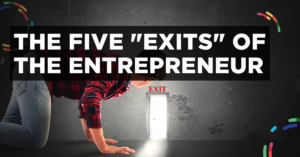NOTE: This is post is part of a series called, How To Build a Scalable Company. Here are the other posts in case you missed them:
Part 1: The 5 Phases of Scalable Companies (you are here)
Part 2: The 4 Types of Scalable Founders
Part 3: Overcoming the 8 Constraints To Scale
Wanna go even deeper? Click here to access The Scalable Operating System Mini-Class
I Have a Confession to Make…
I nearly bankrupted my first company.
After several years of rapid growth and healthy profits, sales stalled and profits dried up…seemingly overnight. And it didn’t make any sense…
We were selling the SAME products to the SAME market leveraging the SAME playbooks that had always worked.
Nothing had changed. And yet, EVERYTHING had changed.
So, in the face of this uncertainty and adversity, I did what any first-time Founder and CEO would do…
…I panicked.
And that was when I made what was probably the worst decision of my entrepreneurial career…
I Fired Myself as CEO of My Own Company
Clearly, I didn’t have the chops to be CEO anymore, so I stepped down from my post and hired a more experienced executive to run the company.
I was ashamed, but I was also relieved.
And at first, things went ok.
My replacement quickly made some cost-cuts (translation: fired a bunch of smart people and cut the ad budget to almost $0) which stabilized our cash flow, but did little to diagnose or treat the actual disease.
Within 6 months, it was clear things were getting worse, not better.
By month 10, we were in a full-blown death spiral.
It wasn’t until my co-founder came to me and said he was going to walk, too, that I finally stepped in, fired the CEO, and re-assumed my previous role at the head of the company.
I was back in charge, but I was still just as clueless the day I “re-hired” myself as I was the day I fired myself.
Worst of all, I was too stupid and too proud to ask for help…
Hitting Rock-Bottom and a Cry for Help
Stepping down as CEO was painful.
Sure, I felt some sense of relief, but mostly I felt shame.
So, during my self-imposed exile, I largely kept to myself. I stopped talking to mentors. I stopped returning calls and texts from peers. And I stopped attending events and masterminds.
I had failed. I was embarrassed. The last thing I wanted to do was talk about it.
And now things were even worse…
Not only had I failed at running my own company, but I had also failed at hiring a replacement to run my company.
Double failure = double shame.
But reality eventually set in: With only 30 days of operating cash in the bank, and most of my credit lines and personal savings already tapped, I couldn’t allow my own ego to deal the final death blow.
I may be proud and foolish, but this was about survival.
So, for the first time in 12 months, I asked for help.
“You Can’t Even Run Your Own Company? Wow, You Are One Pathetic LOSER…”
No exaggeration…that’s literally what I thought people would say when I shared my story and confessed why I had been “off the grid” for the last 12 months.
Fortunately, the reality was very different.
As I talked to my friends and peers, I discovered that we were ALL struggling with the same issues, and we were ALL too afraid to talk about it because we were ALL operating under the illusion that EVERYONE else “had it together.”
Thank God…I WASN’T ALONE!
In fact, just about every entrepreneur I spoke with shared a nearly-identical experience that went something like this…
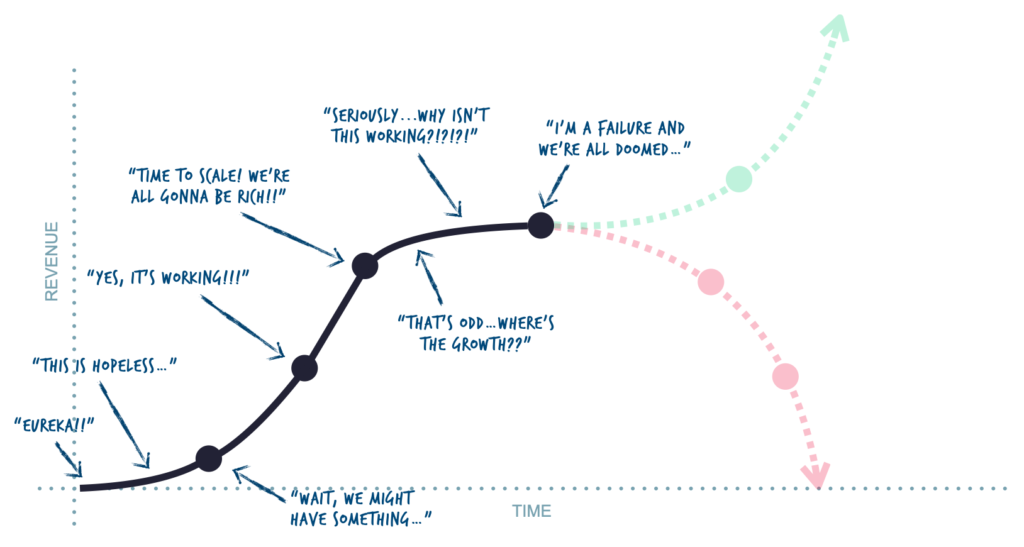
The stories were so similar it was frightening…
For literally ALL of us, the flatlines and ensuing feelings of failure came immediately after a period of massive growth. More surprisingly, it wasn’t the growth that did us in, it was the decision to scale the company to the “next level” after experiencing this massive growth that seemed to seal our fate.
Let me say that, again, because it’s so, so important…
Growth didn’t hurt us. It was the decision to scale immediately following a period of rapid growth that was the most consistent variable in all our flatlines and failures.
In other words, just when we were starting to think we had everything figured out, the walls came crashing down around us.
This realization was painful, but it was also strangely comforting.
Again…I WASN’T ALONE!
None of us were. (And you aren’t, either.)
And most comforting of all, it wasn’t just my peers who identified with this experience.
I soon discovered that my mentors, the people I respected the most because they had “been there and done that,” had gone through the exact same experience…many of them MULTIPLE TIMES in their journey.
“I wish you would have called me before you made the decision to step down,” one of my mentors said. “I could have told you that what you’re going through is nothing new, and it isn’t your fault. It’s just a normal part of the lifecycle of any entrepreneurial company.”
Wait…this was normal?
So maybe I wasn’t a complete failure, after all.
Maybe this is just how business works…
Understanding “S-Curves” in Business
My research and experiences have led me to conclude that the vast, vast majority of businesses follow a similar pattern of growth that resembles an “S-curve.”
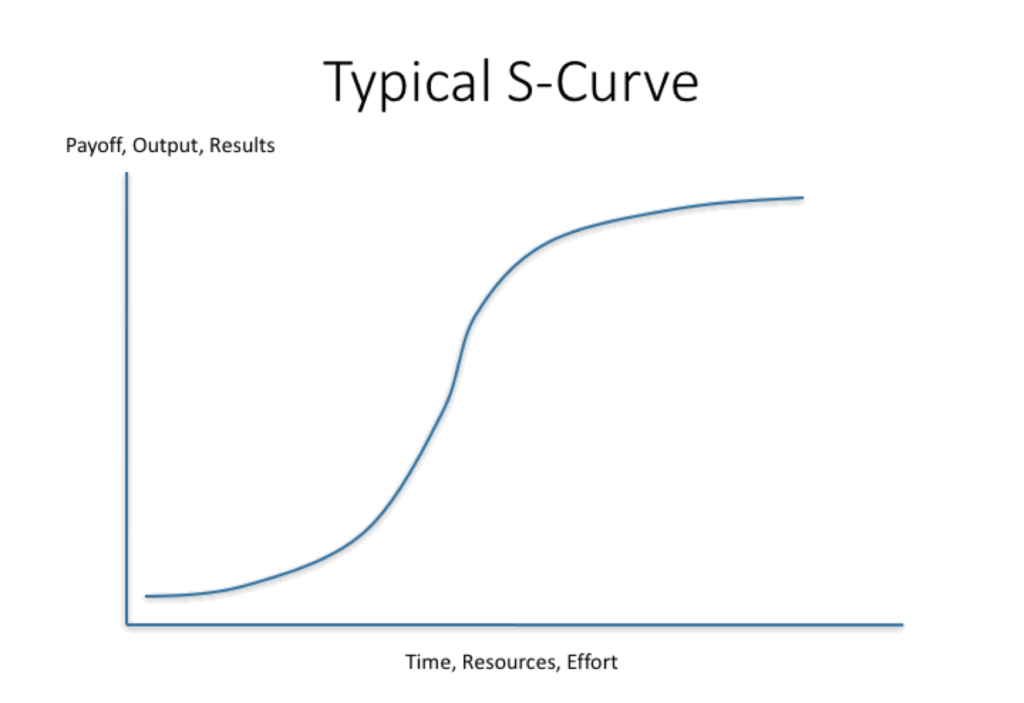
S-curves are not a new concept. Mathematicians call them “sigmoid function,” and they have been a topic of business books for decades. Richard Foster, first wrote about “S curves” and their relation to business and product innovation back in the 1980s, in his book, Innovation…
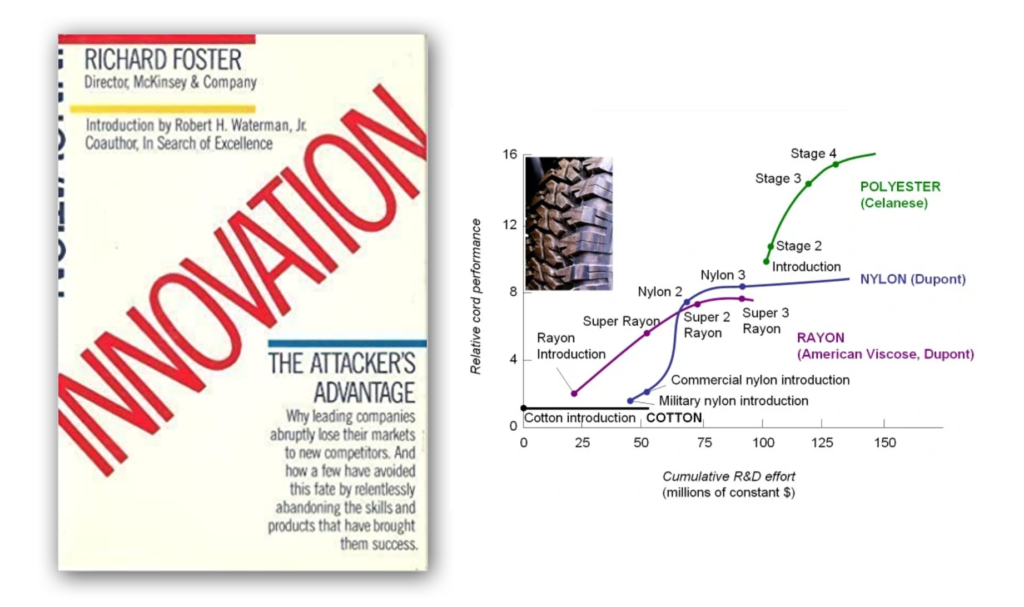
…and some would argue the concept was perfected by Harvard Business School professor, Clayton Christensen, in his seminal work, The Innovator’s Dilemma.
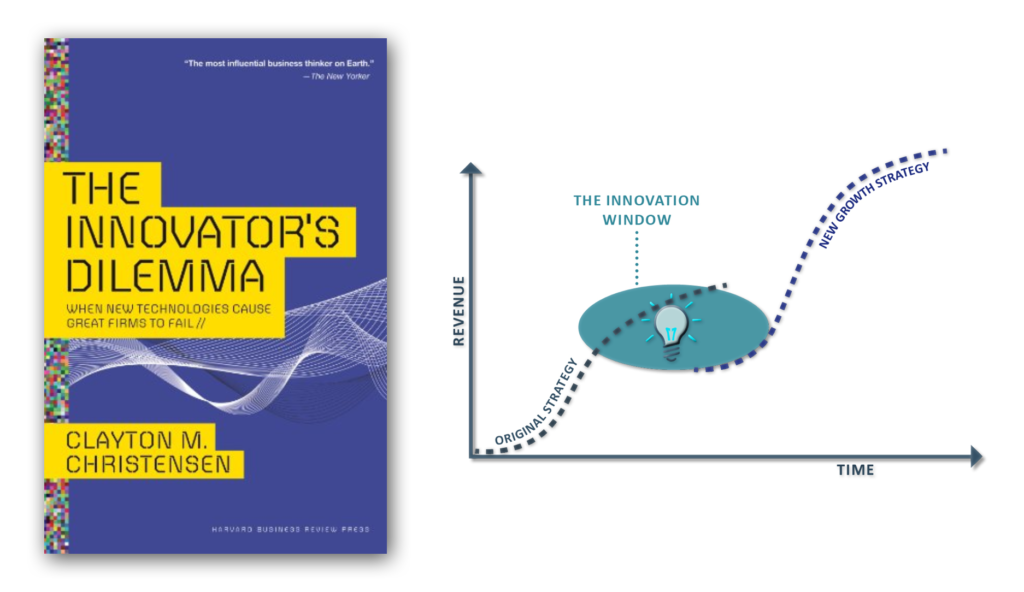
But these were all “fancy-pants” business people talking about giant Fortune 500 companies. Surely these same patterns don’t apply to smaller, entrepreneurial companies, do they?
As it turns out, yes…yes they do.
Introducing: The Entrepreneurial S-Curve (a.k.a. The Entrepreneurial Lifecycle)
Just as patterns in nature exist in both the micro and the macro (for example, sea shells, hurricanes, and even whole galaxies follow a pattern known as a “golden ratio” or “fibonacci spiral”)…

…the same s-curve pattern that causes large businesses to rise and fall can also be detected in younger, smaller companies, too.
This is what we now refer to as “The Entrepreneurial S-Curve,” or better still, “The Entrepreneurial Lifecycle.”
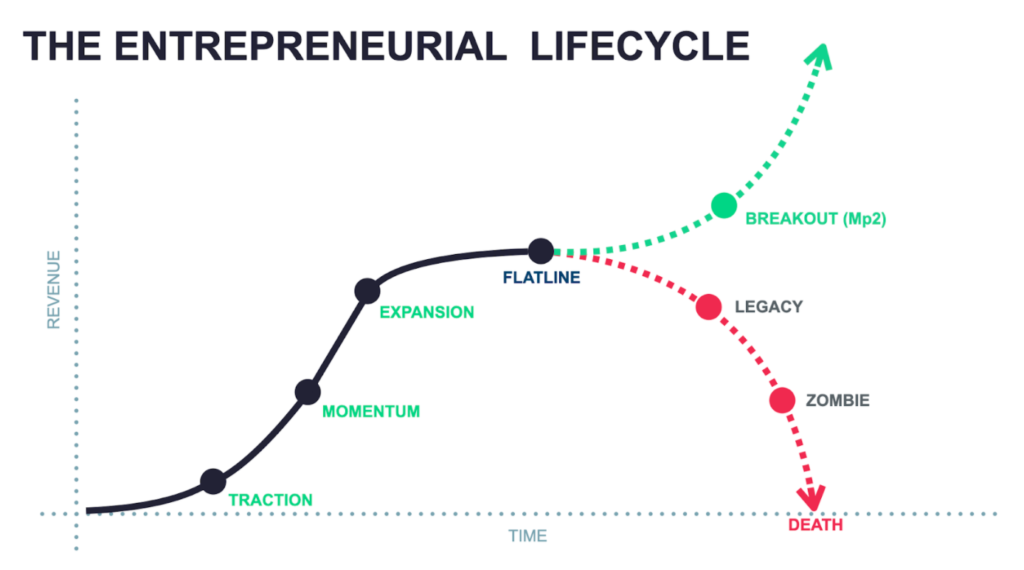
Next, I’m going to break down each phase in the Entrepreneurial Lifecycle. As I do, make a note of which phase best describes where you are right now in your own journey, because diagnose where your business falls along this lifecycle is the first step to achieving true scale and breakout growth.
Ok, let’s dig in…
Phase 1: Traction – “I think we might have something…”
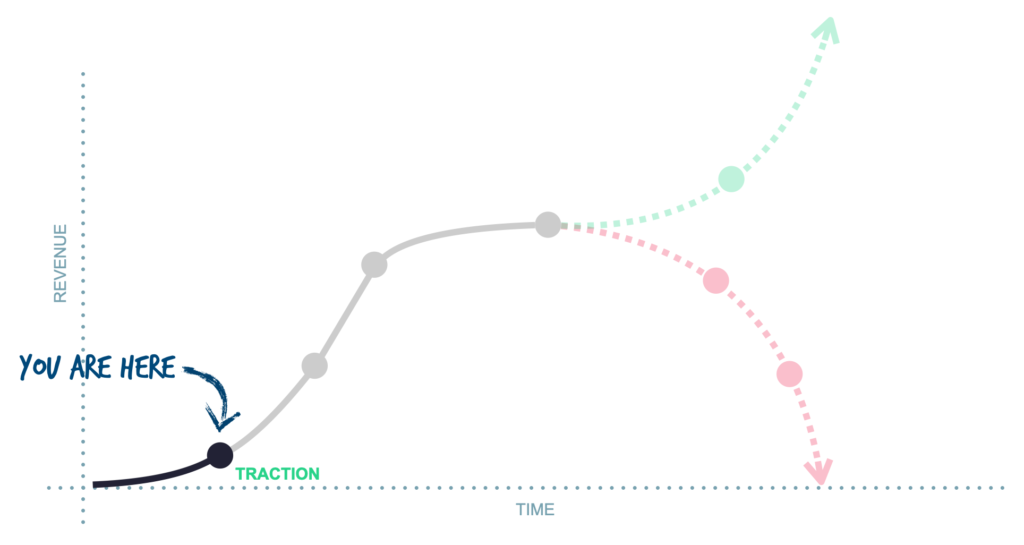
Most companies never get out of the starting gate…
They either fail to find an audience and achieve Product-Market Fit, or they die on the vine due to a lack of action and attention from their founder. But a rare few do make it through to this first phase of the Scalable Lifecycle and achieve true Traction, so if you have, you should be proud.
The Traction Phase is difficult…even painful. But it’s also exhilarating. This is when a business starts making its first sales to someone other than the founder’s mom or old college roommate. And while no one is getting rich during Traction, each day brings just enough excitement and hope to take you through to the next day.
They say the first sale is the most difficult, and in many ways that’s true. But while most startups never achieve true Traction, even fewer make it to Phase 2…
Phase 2: Momentum – “Yes, it’s working!”
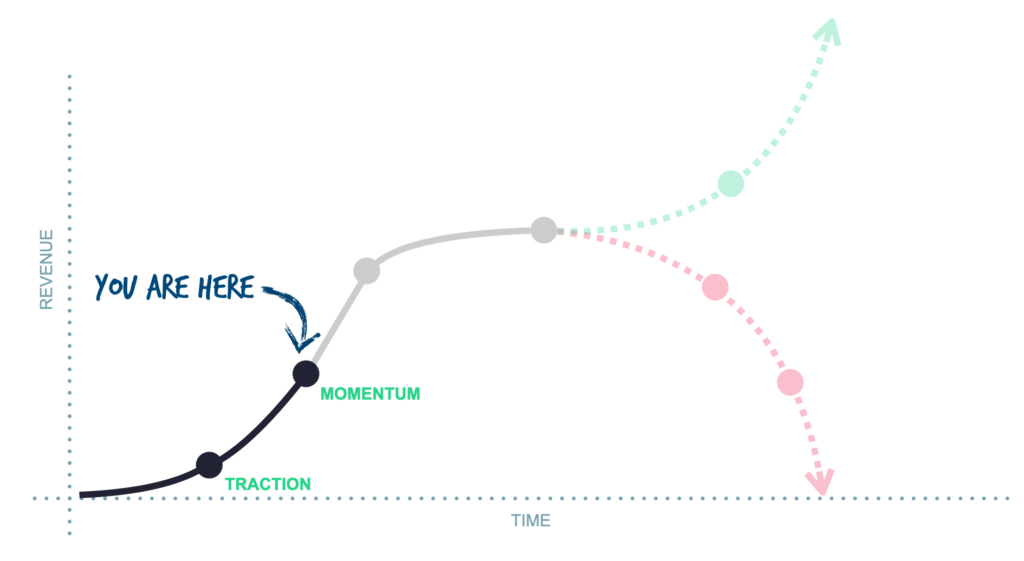
Congratulations!
What started as an idea has taken on a life of its own. And while your business is still quite small both in terms of people and revenue, you have every reason to believe your baby will grow and thrive.
During the Momentum stage, sales are coming through as fast as you can fulfill them (sometimes faster). It’s messy, but customers are happy, morale is high, and your bank balances are starting to swell.
For serial entrepreneurs, this stage is the most fun of all, which is why so many choose to linger here. Some even sabotage their businesses so they return to this stage over and over again. (We’ll talk more about “scale sabotage” later.)
But for most founders, the idea that they should throttle their growth never crosses their mind, and soon they find themselves transitioning into the third phase of the Scalable Lifecycle…
Phase 3: Expansion – “Time To Scale…We’re All Going To Be Rich!!!”
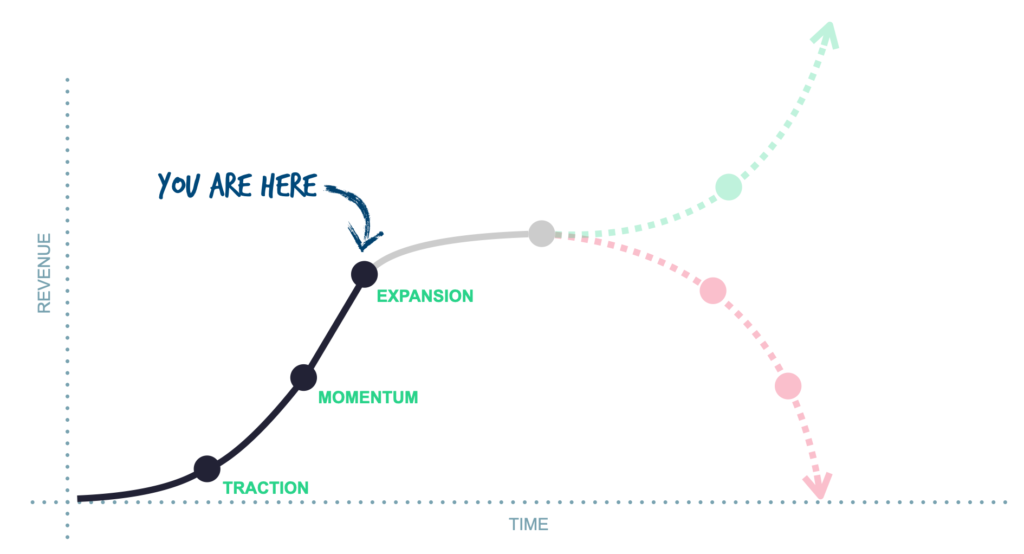
As the excitement of Momentum (Phase 2) starts to wear off, you are left with an uncomfortable truth: you can no longer scale revenue without also scaling expenses.
So that’s exactly what you do…you expand.
It starts with a few key hires, and then moves on to “better” software and systems. Maybe you even splurge on new office space with fancy chairs, standing desks, and motivational posters on every wall.
You’re feeling better. There’s a light at the end of the tunnel, and for the first time your humble startup transforming into a “real business.”
There’s just one problem: It isn’t working.
The revenue spike never materializes. In fact, revenues start to flatten.
But a spike of a different sort does materialize: a spike in complexity.
What was once a fast, nimble business is now slowing under its own weight. Projects that took days now take weeks, and the duct tape and bubble gum that’s been holding all your legacy systems together is starting to break.
These are dangerous times, my friend…
…your business has gone into “Flatline.”
The Flatline – “I’m a Failure and We’re All Doomed…”
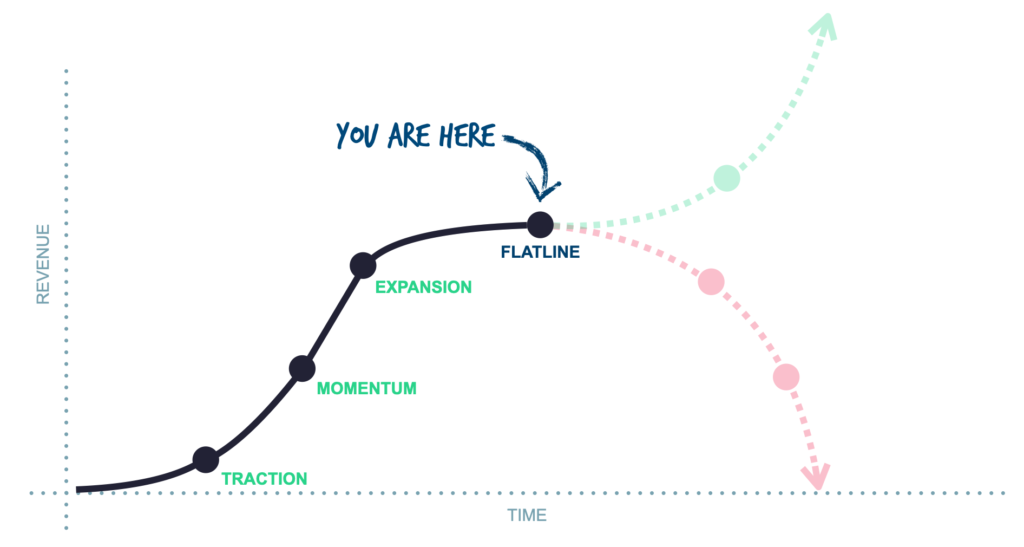
So now we’ve come to it. That point that all businesses and all entrepreneurs ultimately reach if they make it through Traction and Momentum, and then attempt to Expand before they are truly ready.
This is the dreaded Flatline.
This stage has other names. Some call it “The Messy Middle.” Others call it “No Man’s Land.” I call it “The Flatline,” because it not only describes what’s happening to your sales and profit, it also describes what’s happening to your culture and morale…
In a very real sense, the heart of your company has stopped beating.
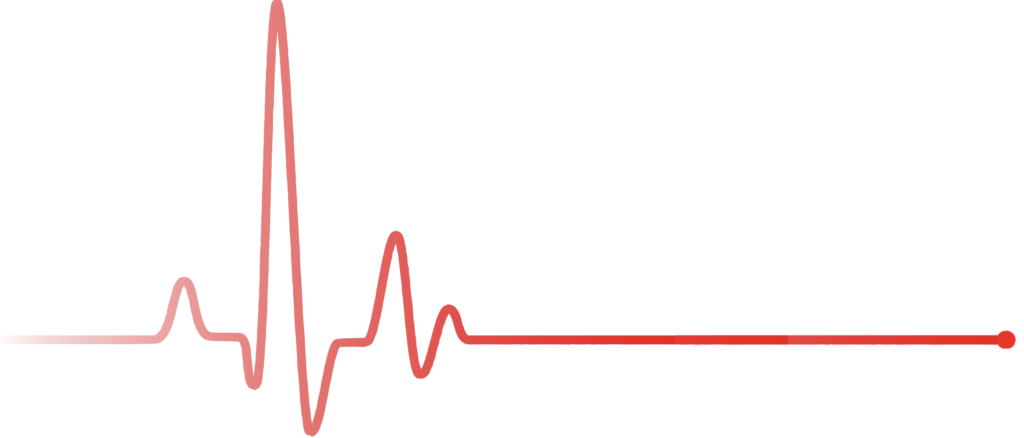
During Flatline, you aren’t making money, you aren’t having fun, and worst of all, you don’t know how to fix it.
In short, you’re stuck. Burnt out.
When you do have a quiet moment to think, you remember the Momentum phase and how fun, free, and profitable everything used to be.
“I liked it better when the business was small and simple. Maybe we just need to take a few steps back.”
In other moments you let your frustrations get the better of you and toy with the idea of just “blowing it up” and starting over again.
“Why am I paying all these people? They were supposed to make my job easier, but it’s only gotten harder! Maybe I should just fire everyone if I’m going to have to do all the work, myself!”
And in your darkest moments, you consider just throwing in the towel…
“Maybe it’s time to shut it down…call it quits…see if I can get my old job back.”
If you have ever thought these thoughts or felt these feelings, don’t fret…you’re in good company. This is the mindset I was in when I made the decision to fire myself and bring in an outside CEO to run the company.
I’m going to show you how to get through this phase, but first, let’s discuss your options…
Denial, Retreat, or Scale? Pick One.
Now that your business is in Flatline, you have a choice to make and you have to make it quickly. Your choices are: Denial, Retreat, or Scale.
Let’s review each, shall we?
OPTION 1: Denial – This one is easy. Just keep doing what you’ve been doing in the hopes that things will get better. And while you’re at it, layer on more processes and bureaucracy, and ratchet up expenses even higher…despite those ever-dwindling profits.
This is the surest path to a death spiral…
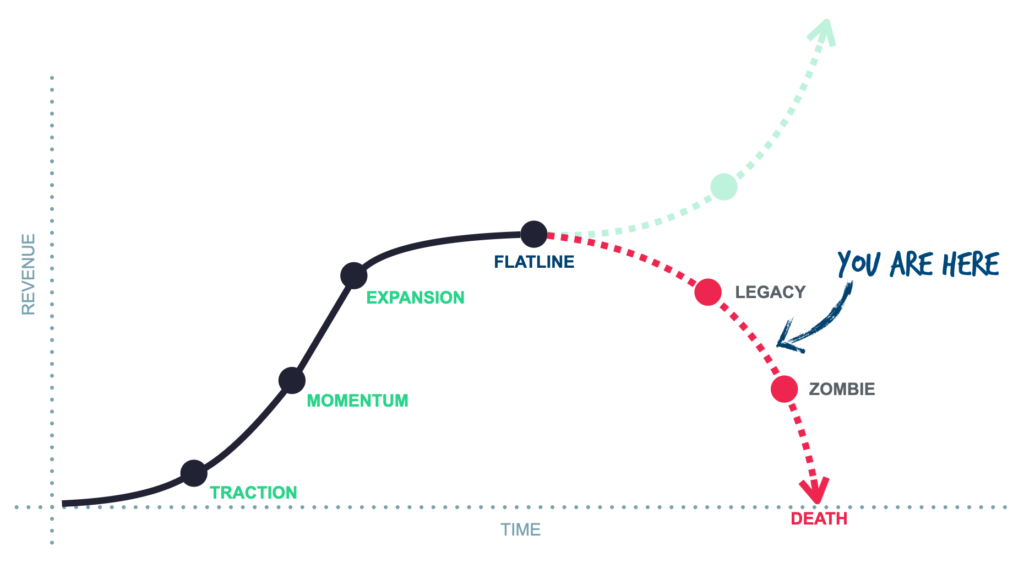
If you are lucky, your company will have enough brand equity built up that the death spiral will be slow and almost unnoticeable at first. You’ll be seen as a “Legacy” brand. Tired and a little bit out of touch, but still worthy of respect and even admiration.
But make no mistake: Denial is still a choice…it’s a choice to do nothing. And by choosing to do nothing, you are choosing Death.
Assuming you don’t see Death as a viable option, then let’s consider happier alternatives…
OPTION 2: Retreat – This is the option many entrepreneurs choose without even realizing it. While retreat takes many forms, from firing whole teams to shutting down entire product lines, the result is the same: the company shrinks back to the size it was during the Momentum phase…back when things were simple, fun, and profitable.
Few entrepreneurs could be blamed for choosing Option 2. In fact, for many, it’s the right strategic choice.
But if you do choose this option, make sure you’re going in with both eyes wide open. By choosing to retreat, you are effectively sabotaging your own business. And sabotage, however strategic, is still a form of destruction, and destruction is always painful.
Your company may survive, but there will be collateral damage to both your culture and your brand.
Fortunately, there is a third option…
OPTION 3: Scale – With this option, you push through the Flatline and finally achieve the breakout growth that will take your company to the next level.
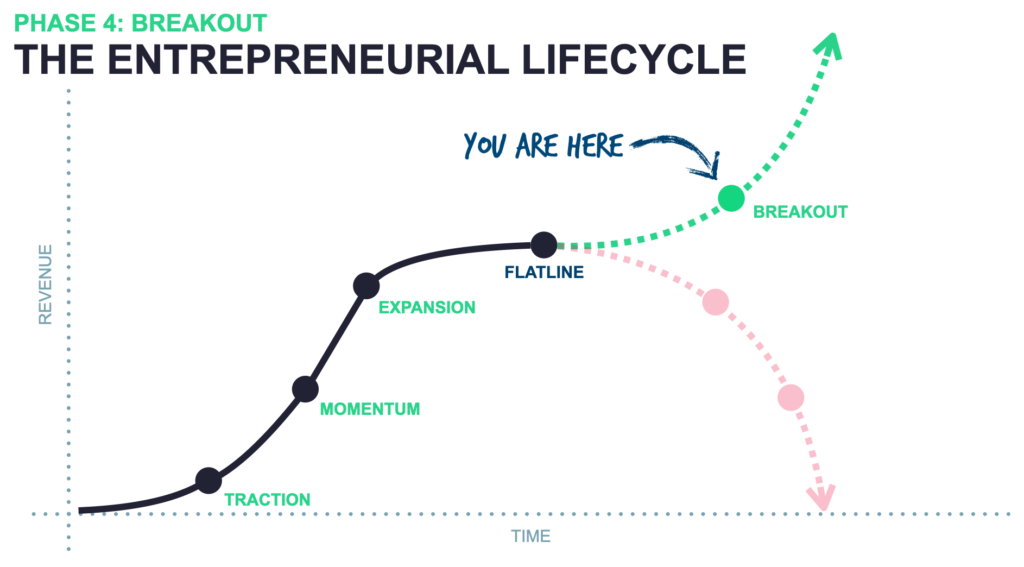
Yes, this is the obvious choice! It’s certainly better than Death, and it’s less humiliating than Sabotaging your own business, right?
Not so fast…
Of the three options, Option 3 (Scale) is the most difficult and even painful of them all.
It sucks to fail. Failure is never fun. But failure during the early stages of the Entrepreneurial Lifecycle is recoverable. You have options. You can pick up the pieces and try again. That’s what Option 2 is all about. It isn’t outright retreat…it’s more like a coordinated withdrawal.
Painful? Yes.
Embarrassing? A little.
Recoverable? Absolutely. (And quickly!)
But the decision to scale is different. Once you choose scale, there is no turning back. You will either achieve Breakout, or you will fail painfully and spectacularly. The stakes are higher and so are the odds against you.
And that’s not the worst part.
Without a doubt, the most difficult part of the scaling process is the change that YOU will have to endure as the founder.
Almost everything that made you great at your company’s previous level will now become a liability.
YOU must change.
Are you willing to do that?
It’s Time To Choose…
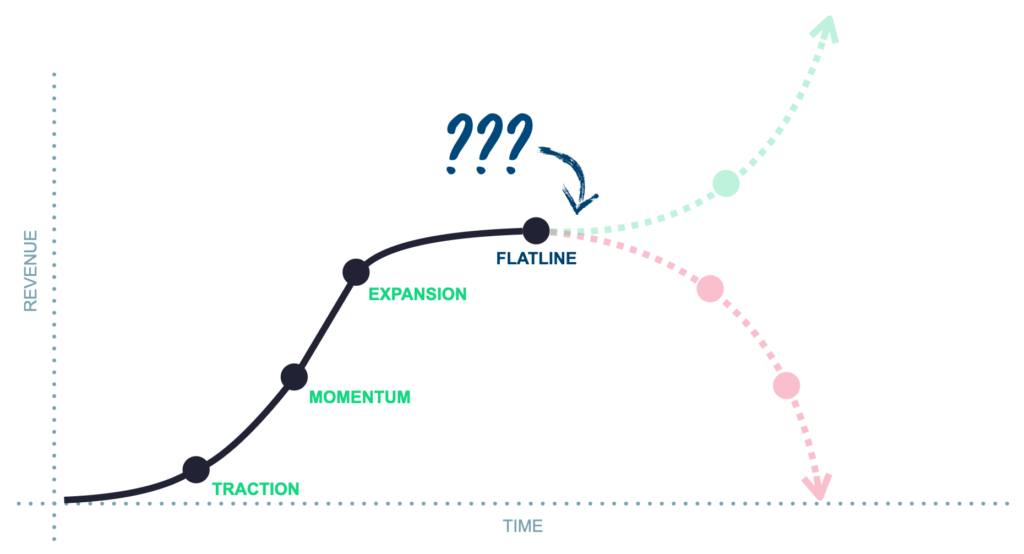
Whether you realize it or not, you have a choice to make.
Choose nothing, and you are choosing death for your company. It may take some time, but make no mistake: the day you choose to stop growing is the day you choose to start dying.
But if you have read this far, then I can only assume that you have chosen scale.
If so, then you’ve come to the right place.
I recommend starting here: The Scalable Operating System
If you want to go deeper, you can get more of our insights and hear stories of our misadventures by subscribing to our newsletter. It’s called “The Memo,” and the first issue will arrive immediately…along with a few other welcome gifts we think you’re really like. 🙂


